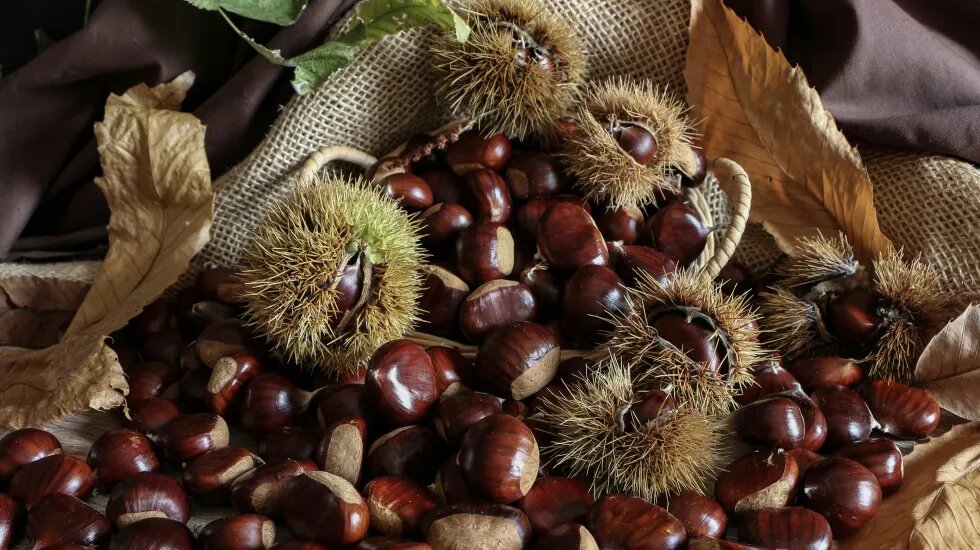On Mount Paiko of the prefecture of Kilkis are some of the most extensive chestnut cultivations in Greece. It is this element that keeps the area alive, however the dual nature of these “chestnut orchards” –on the one hand forests, on the other hand crops– creates problems in their official characterization.

The chestnut trees in Greece are of two forms: the mountainous, with chestnut trees of forests –otherwise chestnut orchards– and the lowlands, created in fields. On the slopes of Paiko, in Central Macedonia, around the villages of Griva, Karpi and Kastaneri, there is a forest of about 1000 hectares with chestnut trees, consisting of private, communal and public spaces. More than 650 of these hectares are cultivated while the rest are considered “wild”. The chestnut tree is a native tree in Paiko, but the chestnut orchards emerged in the last century when the wild chestnut trees were grafted.
Chestnuts are a key axis of the mountain economy development and the survival of the residents of Paiko region and much of the chestnuts’ production is exported. The main problem, according to the chestnut farmers themselves, is that community legislation does not provide that the forest can produce agricultural products. Therefore, what the chestnut farmers are asking is to characterize the chestnut orchards in forest maps as tree cultivation, at least in terms of use.1
Protected area
With the code 9260 «Chestnut Forest» the area Mount Paiko (GR1240009) occupies 1116 hectares of chestnut forests and is one of the 24 areas of the NATURA 2000 network in Greece with this habitat. The management of the protected area belongs to the Management Unit of Prespa National Park and Protected Areas of Western Macedonia of the Natural Environment and Climate Change Agency (N.E.C.C.A.), which is supervised by the Ministry of Environment and Energy.
As mentioned on the website of N.E.C.C.A: “Agricultural activities on Mount Paiko belong to the past and as a result today there is a wide variety of habitats. The reforestation of many abandoned pastures and small pieces of former agricultural land is now creating a landscape of lush vegetation. Thus, the diversity of habitats created is one of the most valuable features of the region. The diversity of the vegetation structure and the proximity of Paiko with Jenna and the valley of Axios river create a suitable habitat for several predators. [...] The main threat to the forests of Mount Paiko is the ever-intensive timber production. Overgrazing in the southern part of the mountain has led to severe cases of soil erosion. Due to the growing timber harvest, a dense road network has been developed and many hectares have been reforested with conifers. Forests due to mismanagement of past decades require special attention for the future. [...] In Paiko is the largest chestnut forest in Greece. [...] Due to the climate in the region the chestnut produced is particularly sweet and tasty».2
The Paiko Agricultural Cooperative of Chestnut Farmers
The Paiko Agricultural Cooperative of Chestnut Farmers was founded in 2019 and 27 out of the approximately 150 producers of the region, participate in it as members. Its purpose on the one hand is the best promotion, exposure and utilization of chestnut and on the other, the strengthening of cooperation between the producers with their respective update on the relevant topics of chestnut and its cultivation. Today the infrastructure of the cooperative can serve on average 250 tons from the 1.000-1.200 tons the region produces in total, and the cooperative plans new infrastructure so that in the future it can serve everyone. Specifically, in 2022 the Cooperative managed 270 tons of chestnut, of which 90% was exported.
Since 1997, the annual chestnut festival takes place on the last Sunday of October in the village of Griva, where most chestnut farmers are located. The president of the Paiko Agricultural Cooperative of Chestnut Farmers, Fotini Vairlis, considers that one of the most important problems is the aging of the population engaged in chestnuts’ cultivation. Chestnut is what holds the population in the area and for this reason, as she emphasized, there is a turn to more organized methods of cultivation, to give young people an incentive to stay in villages, while efforts have been made to invest in processing.
Product processing and protection
Chestnut processing can add great value to the product but also increase its consumption period. Processed products are dry chestnuts for cooking and pastry, liqueurs such as maroncello or chestnut beer, pastries made of chestnut flour etc. As Stefanos Diamantis explains though, ex Regular Researcher of the Institute of Forest Researchers of Thessaloniki, the chestnut product with the greatest surplus value is the marron glacé. However, in order for a manufacturing company of marron glacé to be sustainable, it needs expensive mechanical equipment and large quantities of raw material. For this reason and in the Paiko region, where some timid manufacturing steps have been made, there are only some puree preparation units (pulped chestnut flesh) and chestnut cream (puree with additives such as glucose, vanilla etc.).3
In addition to processing, the Paiko Agricultural Cooperative of Chestnut Farmers cooperates with the Regional Unit of Kilkis in order for the Paiko chestnut to fortify the quality label Protection of Geographical Indication (PGI).4
Footnotes
- 1https://www.amna.gr/home/article/709457/Sunetairismos-sto-Paiko-exagei-to-90-tis-paragogis-kastanou--Poia-einai-ta-problimata-kai-oi-prokliseis
- 2https://necca.gov.gr/mdpp/m-d-ethnikou-parkou-prespon-kai-prostatevomenon-periochon-dytikis-makedonias
- 3“Marron glacé gives surplus value in chestnut”, Outdoors Country 8-11-2016 https://www.ypaithros.gr/iperaxia-sto-kastano-dinei-to-maron-glase/(accessed:15-3-2024)
- 4Under EU quality schemes, product names in which there is an inseparable link between their properties or characteristics and their geographical origin are protected. The geographical indications protect the products from misuse or imitation of the registered name and guarantee consumers the true origin of the product. These rules ensure that the producers of a specific geographical area have collective rights over the product if certain conditions are met.